Key Takeaways
- Understand South Korean labor laws: Familiarize yourself with employment contracts, working hours, minimum wage, leave policies, and termination procedures to ensure compliance and a fair working environment.
- Navigate work permits and visas: Obtain the necessary work permits and visas for non-Korean employees, ensuring compliance with immigration laws and maintaining accurate employee records.
- Prioritize onboarding and cultural integration: Develop a comprehensive orientation program, provide job-specific training, and foster cultural integration to help new hires adapt to your organization and the South Korean work environment successfully.
Welcome to our comprehensive guide on how to hire employees in South Korea.
If you’re a business looking to expand or establish a presence in this vibrant and dynamic country, understanding the local hiring process is crucial for success.
South Korea offers a highly skilled workforce, advanced technology, and a thriving business environment, making it an attractive destination for companies seeking growth opportunities.
However, navigating the intricacies of hiring in South Korea can be challenging, particularly if you’re unfamiliar with the local customs, labor laws, and cultural nuances.
That’s why we’ve created this step-by-step guide to help you streamline your hiring process and find the right talent to fuel your organization’s success.
South Korea’s labor market is unique, shaped by a blend of traditional values, modern practices, and legal frameworks.
As an employer, it’s essential to have a comprehensive understanding of the local landscape to effectively recruit and hire employees who will contribute to your company’s growth and adapt to the cultural context.
Before diving into the hiring process, it’s important to familiarize yourself with the South Korean labor market.
Understanding the current employment trends, market conditions, and industry-specific insights will provide valuable context and guide your recruitment strategy.
Additionally, recognizing the influence of cultural factors on hiring practices will enable you to approach the process with cultural sensitivity, ensuring a smoother experience for both your organization and potential candidates.
Preparing for hiring in South Korea involves conducting thorough research and aligning your hiring needs with the legal requirements.
Familiarize yourself with the local employment laws and regulations governing the hiring process, including work permits, visas, and other legal obligations.
Crafting a detailed job description that clearly outlines the responsibilities, qualifications, and necessary skills for the role is essential to attract suitable candidates and align expectations.
Once you’re ready to source candidates, there are various channels and methods you can utilize.
Local job boards, recruitment agencies, and professional networks can be valuable resources for finding potential employees.
Leveraging local resources and networks not only enhances your chances of reaching qualified candidates but also demonstrates your commitment to engaging with the South Korean talent pool.
Screening and selecting candidates is a critical stage of the hiring process.
Reviewing resumes and applications requires a keen eye for detail and an understanding of local conventions.
When conducting interviews, it’s important to ask relevant questions that assess candidates’ skills, experience, and cultural fit.
Being mindful of cultural differences during the interview process can help you gauge candidates’ adaptability and their potential to thrive within your organization’s work environment.
Negotiating employment terms is another important aspect to consider.
Familiarize yourself with the typical employment terms and conditions in South Korea, including working hours, salary structures, benefits, and contract duration.
Understanding local salary expectations and benefits is crucial for attracting and retaining top talent.
Negotiating and finalizing the employment contract should be done with transparency and fairness, ensuring mutual agreement and compliance with local regulations.
Once you’ve successfully hired a candidate, onboarding and orienting them is key to a seamless integration into your organization.
Establishing a well-structured onboarding process that introduces company policies, procedures, and the organizational culture helps new employees acclimate quickly and become productive members of your team.
Remember to provide support and resources during this transition period to foster a positive employee experience.
Compliance and legal considerations are vital for employers in South Korea.
Adhering to labor laws, tax regulations, and employment contracts is not only essential for the smooth operation of your business but also demonstrates your commitment to responsible and ethical practices.
Stay informed about the legal obligations and compliance requirements specific to South Korea to avoid any legal complications in the future.
Hiring employees in South Korea requires a comprehensive understanding of the local labor market, legal framework, and cultural context.
By following this step-by-step guide, you’ll be equipped with the knowledge and insights needed to navigate the hiring process successfully.
Embrace the opportunity to tap into South Korea’s talented workforce, and build a team that will drive your organization’s growth and success in this exciting business landscape.
Stay tuned as we dive deeper into each step, providing valuable tips, best practices, and expert insights to help you hire employees in South Korea effectively.
Let’s embark on this journey together and unlock the potential of the South Korean job market.
Before we venture further into this article, we like to share who we are and what we do.
About 9cv9
9cv9 is a business tech startup based in Singapore and Vietnam, with a strong presence all over the world.
With over six years of startup and business experience, and being highly involved in connecting with thousands of companies and startups, the 9cv9 team has listed some important learning points in this overview of the guide of how to hire the best employees in South Korea.
If your company needs recruitment and headhunting services to hire top-quality employees, you can use 9cv9 headhunting and recruitment services to hire top talents and candidates. Find out more here, or send over an email to [email protected].
Or just post 1 free job posting here at 9cv9 Hiring Portal in under 10 minutes.
How to Hire Employees in South Korea: A Step-by-Step Guide
- Understanding the South Korean Labor Market
- Preparing for Hiring in South Korea
- Sourcing Candidates in South Korea
- Screening and Selecting Candidates
- Negotiating Employment Terms
- Onboarding and Orienting New Employees
- Compliance and Legal Considerations
1. Understanding the South Korean Labor Market: Overview, Trends, and Insights
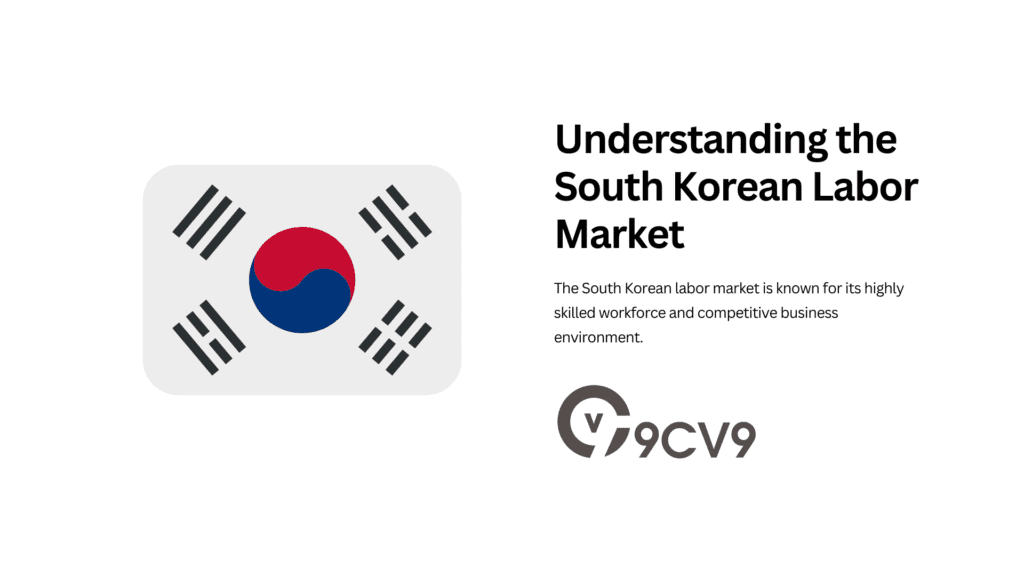
When it comes to hiring employees in South Korea, having a solid understanding of the local labor market is crucial.
This section will provide you with a comprehensive overview of the South Korean labor market, including current trends, market conditions, and valuable insights to guide your hiring strategies.
Overview of the South Korean Labor Market
The South Korean labor market is known for its highly skilled workforce and competitive business environment.
With a population of over 51 million people, South Korea offers a rich talent pool across various industries.
The country’s strong educational system and emphasis on academic excellence contribute to a workforce that is well-prepared for professional roles.
One notable aspect of the South Korean labor market is its focus on academic credentials and qualifications.
Educational achievements, such as prestigious university degrees and certifications, hold significant weight in the hiring process.
This emphasis on educational background reflects the value placed on knowledge and expertise within South Korean society.
Current Employment Trends and Market Conditions
To effectively navigate the South Korean labor market, it’s important to stay informed about current employment trends and market conditions.
Here are some key trends shaping the South Korean labor market:
- Increasing Emphasis on Technological Skills: South Korea is known for its technological advancements and innovation. As a result, there is a growing demand for professionals with expertise in areas such as artificial intelligence, data analytics, cybersecurity, and software development. Companies seeking to hire employees in South Korea should prioritize candidates with relevant technical skills to stay competitive.
- Rising Importance of Startups and Entrepreneurship: South Korea has witnessed a surge in startup activity in recent years. The government has implemented various initiatives to support entrepreneurship and foster a vibrant startup ecosystem. As a result, many talented professionals are drawn to startups, creating new opportunities for both job seekers and employers. Consider tapping into the startup community when looking for innovative talent.
- Shift towards Flexible Work Arrangements: Like many countries, South Korea has experienced a shift towards flexible work arrangements. Remote work, freelancing, and flexible hours have gained popularity, especially in sectors such as IT, digital marketing, and creative industries. Employers should be open to these flexible arrangements to attract a wider range of skilled professionals.
Cultural Factors Influencing the Labor Market
In addition to understanding the economic and industry-specific aspects of the South Korean labor market, it’s essential to consider cultural factors that impact hiring practices.
South Korean culture places a strong emphasis on hierarchy, respect for authority, and collective harmony.
These cultural values often shape workplace dynamics and influence the hiring process.
- Formality and Respect: In South Korean business culture, formalities and respect for hierarchical structures are highly valued. It’s important to maintain professional etiquette during interviews and interactions with candidates. Use appropriate titles and honorifics when addressing individuals, especially those in higher positions.
- Confucian Principles: Confucianism has significantly influenced South Korean society and workplace dynamics. Key principles, such as loyalty, respect for elders, and the importance of harmony, are ingrained in the culture. Employers should be mindful of these values and seek candidates who align with them to ensure a cohesive and harmonious work environment.
- Team-oriented Approach: Collaboration and teamwork are essential in South Korean workplaces. Demonstrating the ability to work well in a team and fostering a collaborative culture can greatly impact the success of your hiring efforts. Look for candidates who exhibit strong teamwork skills and have experience in group projects or team-based environments.
By understanding the South Korean labor market, including its current trends, market conditions, and cultural nuances, you can tailor your hiring strategies to attract the right talent and build a successful team.
Stay tuned as we explore the next steps in our comprehensive guide on how to hire employees in South Korea, equipping you with the knowledge and insights needed for a successful hiring process.
2. Preparing for Hiring in South Korea: Research, Legal Considerations, and Job Description
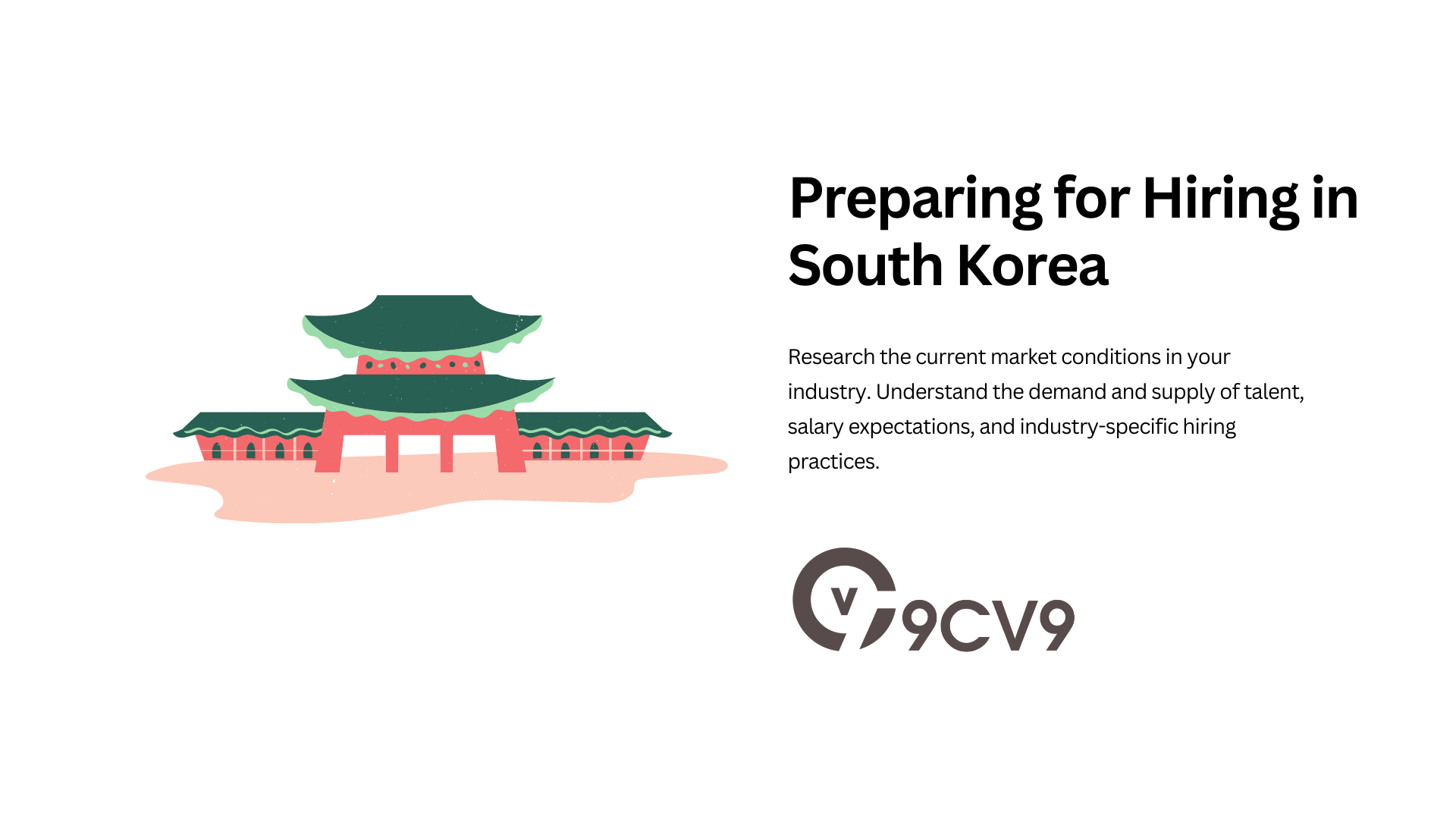
When it comes to hiring employees in South Korea, thorough preparation is key to ensuring a smooth and successful process.
This section will guide you through the essential steps of preparing for hiring in South Korea, including conducting research, understanding the legal considerations, and crafting a compelling job description.
Conduct Research:
Before diving into the hiring process, it’s important to conduct comprehensive research to align your hiring needs with the South Korean market.
Here are some key aspects to consider:
a. Market Analysis: Research the current market conditions in your industry. Understand the demand and supply of talent, salary expectations, and industry-specific hiring practices. This knowledge will help you position your company competitively in the market.
b. Competitor Analysis: Study your competitors’ hiring strategies, employee benefits, and work culture. Identifying their strengths and weaknesses will enable you to differentiate your organization and attract top talent.
c. Skill Requirements: Identify the specific skills and qualifications necessary for the role you’re hiring for. South Korea boasts a highly educated workforce, so determining the precise skills needed will help you target the right candidates.
Understand Legal Considerations:
Comprehending the legal framework and employment laws in South Korea is crucial to ensure compliance and mitigate any potential risks. Consider the following:
a. Work Permits and Visas: Determine the requirements for work permits and visas, depending on the nationality of the candidates you intend to hire. Familiarize yourself with the necessary documentation and the process of obtaining work permits for foreign employees.
b. Employment Contracts: Understand the legal obligations and components of employment contracts in South Korea. Key elements include terms and conditions, compensation, working hours, benefits, and termination procedures. Ensure your contracts align with the local regulations.
c. Labor Laws: Familiarize yourself with the labor laws and regulations governing employment relationships, including minimum wage, working hours, leave entitlements, and workplace safety. Complying with these laws is essential to avoid legal complications and maintain a fair work environment.
Craft a Compelling Job Description:
A well-crafted job description plays a vital role in attracting qualified candidates.
Here are some tips for creating a compelling job description for hiring in South Korea:
a. Job Title: Choose a job title that accurately reflects the role and aligns with local conventions. Use common industry terminology to ensure clarity.
b. Responsibilities and Duties: Clearly outline the specific responsibilities and duties associated with the role. Be concise and precise, highlighting the key tasks and expectations.
c. Qualifications and Skills: Specify the required qualifications, degrees, certifications, and relevant experience necessary for the role. Emphasize any specific technical or language skills essential for the position.
d. Cultural Fit: Consider mentioning the desired cultural fit for your organization. South Korean companies value teamwork, respect for authority, and harmony. Indicate if you seek candidates who align with these values.
e. Compensation and Benefits: Provide a general overview of the compensation package and benefits offered. While exact figures may be discussed during negotiations, giving candidates an idea of the salary range and additional perks can attract the right candidates.
f. Application Instructions: Clearly state how candidates should apply, including the required documents and preferred method of submission. Provide contact details for inquiries.
By thoroughly preparing for hiring in South Korea through research, understanding legal considerations, and crafting a compelling job description, you set a strong foundation for attracting and selecting the right candidates. Stay tuned for the next steps in our comprehensive guide on how to hire employees in South Korea, equipping you with the knowledge and insights needed for a successful hiring process.
Also, do have a read at our most popular guide: Mastering the Art of Writing Effective Job Descriptions: A Comprehensive Guide
3. Sourcing Candidates in South Korea: Strategies, Job Boards, and Networking
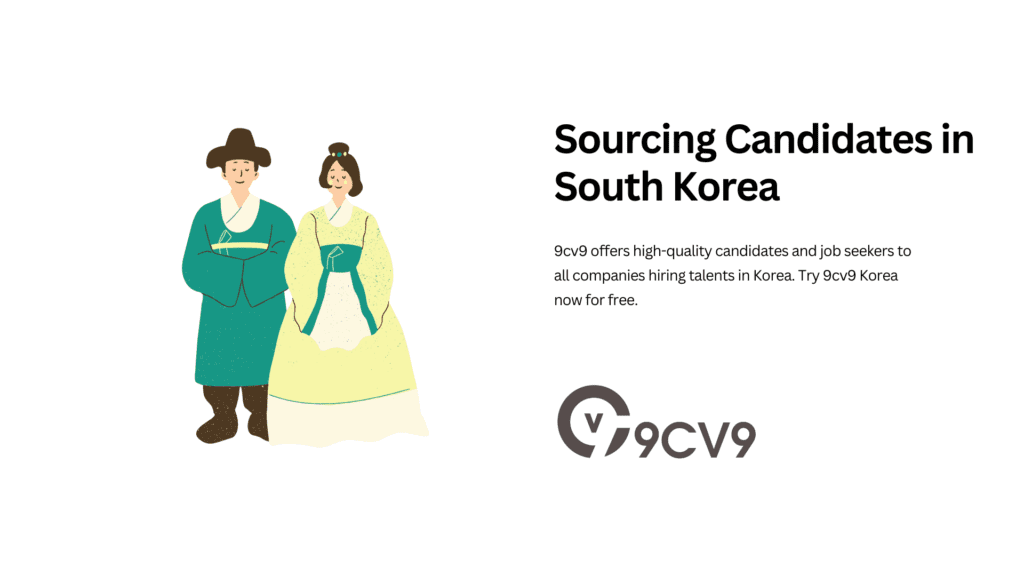
Sourcing candidates in South Korea requires a proactive approach to tap into the country’s diverse talent pool.
This section will provide you with valuable insights and strategies to effectively source candidates, including leveraging job boards, recruitment agencies, and networking opportunities.
Job Boards:
Job boards play a significant role in connecting employers with potential candidates.
In South Korea, several popular job boards cater to both general and industry-specific roles. Here are some prominent job boards to consider:
a. 9cv9 Korea: A new and fast-growing job board in Korea. 9cv9 offers high-quality candidates and job seekers to all companies hiring talents in Korea. Try 9cv9 Korea now for free.
b. Saramin: Saramin is another popular job board known for its user-friendly interface and extensive job listings. It covers diverse industries and offers features such as applicant tracking systems (ATS) and company profiles.
c. JobKorea: JobKorea is one of the largest job portals in South Korea, offering a wide range of job opportunities across various industries. It attracts a large user base and provides features such as resume database access and employer branding options.
d. Wanted: Wanted is a job board known for its emphasis on startup and tech-related roles. It caters to candidates seeking opportunities in innovative and fast-growing companies.
When utilizing job boards, optimize your job postings with relevant keywords, clear job titles, and detailed job descriptions. Include specific qualifications, skills, and experience requirements to attract candidates.
Recruitment Agencies
Recruitment agencies in South Korea can provide valuable assistance in finding suitable candidates for your organization.
These agencies have extensive networks and expertise in specific industries.
Consider the following when engaging with recruitment agencies:
a. Research and Shortlist: Conduct thorough research to identify reputable recruitment agencies that specialize in your industry or the specific job role you are hiring for. Shortlist agencies based on their expertise, track record, and client feedback.
b. Collaboration and Communication: Establish a collaborative relationship with the recruitment agency of your choice. Clearly communicate your hiring requirements, job specifications, and cultural preferences. Regularly communicate and provide feedback to ensure the agency understands your organization’s needs.
c. Evaluate Candidates: Once the agency presents potential candidates, evaluate them based on their qualifications, skills, and cultural fit. Provide timely feedback to the agency to refine the candidate selection process.
d. Use 9cv9 Recruitment Agency: 9cv9 is one of the leading and most well-known headhunters and recruitment agencies in Asia. Tap into 9cv9 15,000+ recruiters and HRtech to hire your next hire. Find out more here, or send over an email to [email protected].
Networking:
Networking plays a crucial role in sourcing candidates in South Korea.
Building relationships and engaging with local professionals and organizations can help you access a hidden talent pool.
Consider the following networking strategies:
a. Industry Events and Conferences: Attend industry events, conferences, and seminars to connect with professionals in your field. These gatherings provide opportunities to build relationships, exchange ideas, and identify potential candidates.
b. Online Professional Networks: Engage with online professional networks such as LinkedIn to connect with South Korean professionals. Join relevant groups and participate in discussions to expand your network and increase visibility.
c. Local Partnerships: Collaborate with local universities, professional associations, and industry organizations. Explore partnerships for internships, mentorship programs, or speaking engagements to showcase your organization and attract talented individuals.
d. Employee Referrals: Encourage your existing employees to refer potential candidates. Implement an employee referral program to incentivize referrals and tap into their networks. Using Jobsrefer will accelerate the process faster as Jobsrefer uses a decentralized platform to connect your company to 15,000+ freelance referrers and recruiters.
Remember to maintain a professional and culturally sensitive approach when networking in South Korea.
Building trust and fostering relationships are key factors in sourcing candidates effectively.
By leveraging job boards, collaborating with recruitment agencies, and actively networking, you can tap into South Korea’s talent pool and identify qualified candidates for your organization.
In the next section of our comprehensive guide on how to hire employees in South Korea, we will explore the essential steps of screening and selecting candidates, ensuring you make informed hiring decisions.
Stay tuned for valuable insights and best practices.
4. Screening and Selecting Candidates in South Korea: Best Practices, Interviews, and Assessment Methods

The screening and selection process is a critical stage in hiring employees in South Korea.
This section will provide you with valuable insights and best practices to effectively evaluate candidates, conduct interviews, and utilize assessment methods tailored to the South Korean context.
Application Screening:
The initial step in screening candidates involves reviewing their applications, resumes, and cover letters. Here are some best practices to consider:
a. Review for Qualifications: Assess candidates’ qualifications, educational background, and relevant work experience. Look for specific skills, certifications, or industry-related achievements that align with your job requirements.
b. Attention to Detail: South Korean candidates often emphasize attention to detail. Assess their application materials for professionalism, formatting, and accuracy in grammar and spelling.
c. Cultural Fit: Look for indications of cultural fit within the candidate’s application. Consider their alignment with the organization’s values, teamwork orientation, and respect for authority.
Interviews:
Interviews play a crucial role in assessing a candidate’s suitability for a position. When conducting interviews in South Korea, consider the following:
a. Structured Interviews: Prepare a structured interview format with standardized questions to ensure fairness and consistency. This approach enables effective comparisons between candidates.
b. Cultural Sensitivity: Show respect for hierarchy and formalities during interviews. Address candidates using appropriate titles and honorifics, especially when interacting with senior professionals.
c. Behavioral Questions: Include behavioral questions to gauge how candidates handle specific situations or challenges. Assess their problem-solving abilities, teamwork skills, and adaptability.
d. Technical Assessments: Depending on the job role, consider incorporating technical assessments or assignments to evaluate candidates’ practical skills and knowledge.
Assessment Methods:
Supplementing interviews with assessment methods can provide a more comprehensive evaluation of candidates’ capabilities. Consider the following assessment methods:
a. Cognitive and Psychometric Tests: Utilize cognitive ability tests or psychometric assessments to measure candidates’ problem-solving skills, critical thinking abilities, and personality traits. These assessments can provide insights into their potential fit for the role and the organization.
b. Simulations and Case Studies: Develop simulations or case studies that mimic real-life work scenarios. This allows candidates to showcase their problem-solving skills, decision-making abilities, and job-related knowledge.
c. Reference Checks: Conduct reference checks with the candidate’s previous employers or professional contacts. This helps verify their qualifications, work ethics, and overall performance.
Cultural Adaptability:
Assessing a candidate’s cultural adaptability is essential when hiring in South Korea.
Look for indications of cross-cultural experiences, international exposure, or adaptability to different work environments.
Candidates who have demonstrated cultural adaptability can contribute positively to your organization’s dynamics.
Collaboration with Local Experts:
Collaborating with local professionals, consultants, or advisors can provide valuable insights during the screening and selection process.
They can offer guidance on cultural nuances, interpret candidates’ qualifications, and help you make informed hiring decisions.
Timely Communication:
Throughout the screening and selection process, ensure timely and transparent communication with candidates.
This demonstrates professionalism and respect for their time and effort.
Providing feedback, whether positive or negative, is crucial in maintaining a positive employer brand reputation.
By following best practices, conducting structured interviews, utilizing assessment methods, and considering cultural adaptability, you can effectively screen and select candidates in South Korea.
In the next section of our comprehensive guide on how to hire employees in South Korea, we will delve into the crucial step of onboarding and integrating new hires into your organization.
5. Negotiating Employment Terms in South Korea: Compensation, Benefits, and Contractual Agreements

Negotiating employment terms is a crucial step in the hiring process in South Korea.
This section will provide you with valuable insights and best practices to effectively negotiate employment terms, including compensation, benefits, and contractual agreements, ensuring a fair and mutually beneficial arrangement for both parties.
Compensation:
Determining a competitive and fair compensation package is essential to attract and retain top talent in South Korea.
Consider the following factors when negotiating compensation:
a. Market Research: Conduct thorough market research to understand the prevailing salary ranges for similar positions in your industry and region. This knowledge will help you set realistic compensation expectations.
b. Base Salary: Determine the base salary, considering the candidate’s qualifications, skills, experience, and the scope of the role. Take into account the local cost of living, industry standards, and internal salary structures.
c. Performance-Based Incentives: Consider incorporating performance-based incentives, such as bonuses or commissions, to motivate and reward employees for their contributions. Clearly define the performance metrics and the criteria for earning these incentives.
d. Benefits and Perks: Alongside base salary, consider offering a comprehensive benefits package. Common benefits in South Korea include health insurance, retirement plans, paid time off, and professional development opportunities. Assess the market standards and tailor the benefits package to align with the candidate’s needs and expectations.
Contractual Agreements:
Establishing clear and legally sound contractual agreements is vital to protect the rights and obligations of both the employer and the employee.
Consider the following aspects during contract negotiations:
a. Employment Contract Types: South Korea offers various types of employment contracts, including indefinite-term contracts, fixed-term contracts, and project-based contracts. Choose the contract type that aligns with the nature of the role and your business requirements.
b. Contract Terms and Conditions: Clearly outline the terms and conditions of employment, including working hours, probationary periods, notice periods, and termination procedures. Ensure compliance with South Korean labor laws and regulations.
c. Non-Disclosure and Non-Compete Clauses: Consider including non-disclosure and non-compete clauses in the employment contract to protect your company’s confidential information and prevent employees from competing with your organization after termination.
d. Severance Pay: Familiarize yourself with the legal requirements for severance pay in South Korea. Ensure that the contract accurately reflects the terms for severance pay in compliance with local labor laws.
Negotiation Strategies:
Effective negotiation requires a strategic approach to reach a mutually beneficial agreement.
Consider the following strategies when negotiating employment terms:
a. Preparation: Thoroughly understand your organization’s budget constraints, salary bands, and benefit policies before entering into negotiations. Be prepared to explain the rationale behind the offered compensation package and articulate the value proposition of joining your company.
b. Flexibility: Maintain a degree of flexibility during negotiations. Consider alternative ways to structure the compensation package, such as offering additional benefits or opportunities for career advancement.
c. Active Listening: Listen attentively to the candidate’s expectations and concerns. Understanding their needs and motivations will enable you to address them effectively and find common ground.
d. Win-Win Approach: Strive for a win-win outcome where both parties feel satisfied with the final agreement. Avoid an overly aggressive or adversarial stance, as it may negatively impact the working relationship.
Consultation with Legal Experts:
Consider seeking advice from legal experts or employment law consultants to ensure that the negotiated terms comply with South Korean labor laws and regulations.
Their expertise can help you navigate legal complexities and mitigate any potential risks.
By employing strategic negotiation techniques, conducting market research, and considering legal implications, you can navigate the process of negotiating employment terms in South Korea successfully.
In the next section of our comprehensive guide on how to hire employees in South Korea, we will explore the crucial step of onboarding and integrating new hires into your organization.
6. Onboarding and Orienting New Employees in South Korea: Best Practices, Training, and Cultural Integration
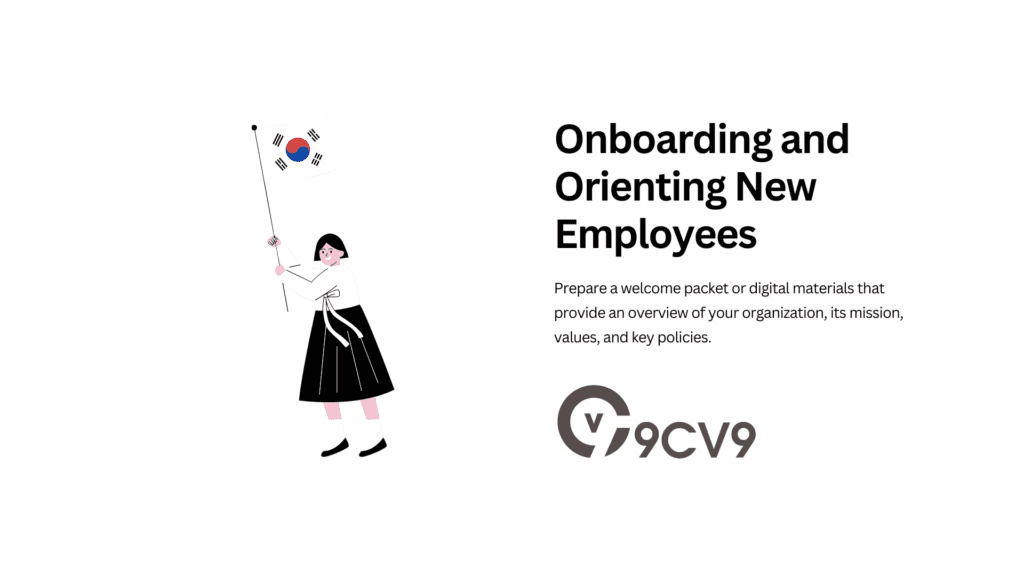
Onboarding and orienting new employees effectively is crucial to their successful integration into your organization in South Korea.
This section will provide you with valuable insights and best practices to ensure a smooth onboarding process, comprehensive training, and cultural integration for new hires.
Preparing for Onboarding:
Effective onboarding starts before the new employee’s first day.
Consider the following steps to ensure a seamless transition:
a. Welcome Materials: Prepare a welcome packet or digital materials that provide an overview of your organization, its mission, values, and key policies. Include information about the employee’s specific role and responsibilities.
b. Equipment and Workspace: Set up the employee’s workspace with necessary equipment, tools, and technology. Ensure they have the resources needed to perform their job effectively from day one.
c. Introduction to Colleagues: Inform existing team members about the new hire and encourage them to reach out and welcome the newcomer. Assign a mentor or buddy to provide guidance and support during the onboarding process.
Comprehensive Orientation:
A comprehensive orientation program is essential to familiarize new employees with your organization’s culture, policies, and procedures.
Consider the following elements when designing an orientation program:
a. Company Overview: Provide a detailed overview of your organization’s history, mission, values, and strategic goals. Help new hires understand your company’s unique selling points and competitive advantages.
b. Organizational Structure: Explain the organizational structure, reporting lines, and key departments within your company. This will help new employees understand how their role fits into the bigger picture.
c. Policies and Procedures: Communicate important policies and procedures, such as code of conduct, dress code, leave management, and performance evaluation processes. Ensure new employees understand and adhere to these policies.
d. Compliance and Legal Requirements: Familiarize new hires with legal requirements, such as labor laws, safety regulations, and data protection laws specific to South Korea. Highlight their rights and responsibilities as employees.
e. Benefits and Employee Resources: Provide a comprehensive overview of the employee benefits package, including healthcare, retirement plans, and any other perks or resources available to employees. Explain how to access and utilize these benefits.
Job-Specific Training:
Job-specific training is essential to equip new employees with the necessary skills and knowledge to excel in their roles.
Consider the following approaches to job-specific training:
a. Training Programs: Develop training programs tailored to the specific job roles, covering both technical and soft skills. Provide hands-on training, workshops, and online resources to support their learning and development.
b. Mentorship and Shadowing: Pair new employees with experienced team members who can serve as mentors or provide opportunities for shadowing. This enables new hires to observe and learn from experienced professionals in real work scenarios.
c. Cross-Functional Exposure: Encourage cross-functional collaboration and exposure to different departments within your organization. This helps new employees gain a holistic understanding of the company’s operations and build internal networks.
Cultural Integration:
Successful cultural integration is crucial for new employees to feel a sense of belonging and effectively collaborate with their colleagues.
Consider the following strategies for cultural integration:
a. Cultural Orientation: Provide an orientation on South Korean culture, customs, and workplace norms. Highlight the importance of respect, hierarchy, and teamwork within the local work environment.
b. Language Support: Offer language support, such as language classes or language resources, to help non-Korean employees navigate communication challenges and adapt to the local language.
c. Team-Building Activities: Organize team-building activities to foster camaraderie and collaboration among employees. This could include social events, offsite retreats, or team-building exercises that promote cross-cultural understanding.
d. Employee Engagement: Foster an inclusive and engaging work environment that encourages employee participation and feedback. Encourage new employees to share their ideas, perspectives, and cultural experiences.
Ongoing Support and Feedback:
Support and feedback are essential throughout the onboarding process.
Consider the following practices to ensure ongoing support:
a. Regular Check-Ins: Schedule regular check-in meetings with new employees to address any concerns, provide feedback, and assess their progress. Create a safe space for open dialogue and encourage them to share their experiences and challenges.
b. Continuous Learning Opportunities: Offer continuous learning and development opportunities to help new employees enhance their skills and knowledge. This could include access to training programs, conferences, or professional certifications.
c. Performance Management: Establish a robust performance management system that provides clear performance expectations, regular performance evaluations, and opportunities for career growth. Provide constructive feedback and recognition for achievements.
d. Employee Well-Being: Prioritize employee well-being by promoting work-life balance, mental health support, and initiatives that foster a healthy and positive work environment.
By implementing comprehensive onboarding, providing job-specific training, and promoting cultural integration, you can set new employees up for success in South Korea.
In the next section of our comprehensive guide on how to hire employees in South Korea, we will explore strategies for employee engagement and retention.
7. Compliance and Legal Considerations for Hiring Employees in South Korea: Labor Laws, Work Permits, and Employment Regulations
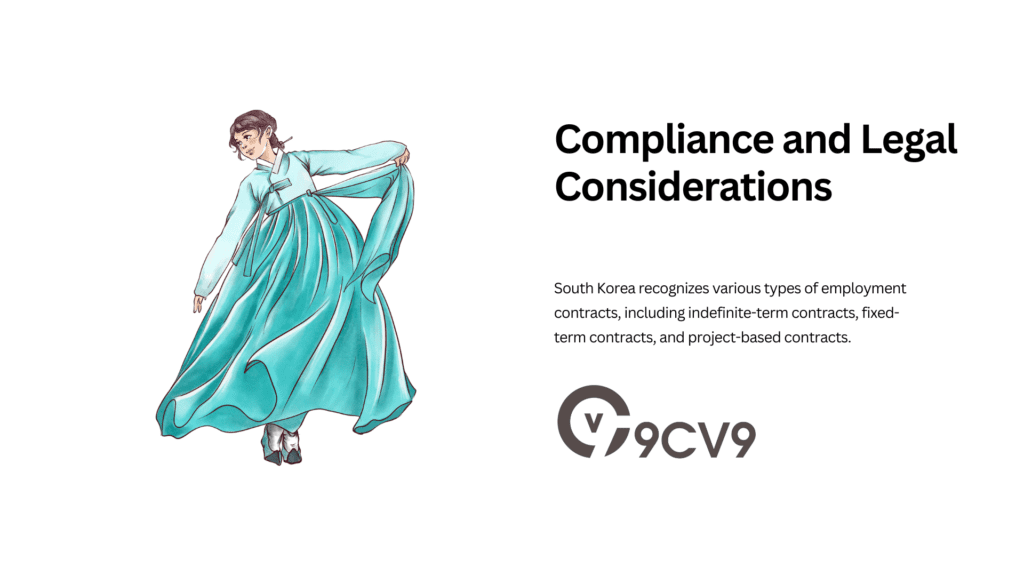
When hiring employees in South Korea, it is crucial to navigate the complex landscape of compliance and legal considerations.
This section will provide you with valuable insights and best practices to ensure compliance with labor laws, obtain work permits, and adhere to employment regulations in South Korea.
Understanding Labor Laws:
Familiarizing yourself with South Korean labor laws is essential to ensure compliance throughout the hiring process.
Consider the following key aspects:
a. Employment Contracts: South Korea recognizes various types of employment contracts, including indefinite-term contracts, fixed-term contracts, and project-based contracts. Ensure that the contract type aligns with the nature of the role and complies with legal requirements.
b. Working Hours: South Korean labor laws stipulate maximum working hours and rest periods. As of the knowledge cutoff date in September 2021, the legal maximum is 40 hours per week, with additional provisions for overtime work and rest days. Stay updated on any revisions to the labor laws to maintain compliance.
c. Minimum Wage: South Korea sets a minimum wage that employers must adhere to. Ensure that the salary offered to employees meets or exceeds the minimum wage requirements.
d. Leave and Holidays: Familiarize yourself with the regulations concerning annual leave, sick leave, maternity/paternity leave, and public holidays. Ensure that your policies align with the minimum requirements outlined in the labor laws.
e. Termination and Severance: Understand the legal provisions regarding termination of employment, notice periods, and severance pay. Adhere to the appropriate procedures and fulfill your obligations to employees when terminating their contracts.
Work Permits and Visas:
For non-Korean nationals, obtaining the necessary work permits and visas is crucial before they can legally work in South Korea.
Consider the following steps:
a. Work Visa Categories: South Korea offers various work visa categories, including E-1 for professors, E-2 for foreign language instructors, E-7 for skilled workers, and more. Determine the appropriate visa category for your employee based on their job role and qualifications.
b. Sponsorship and Application: As an employer, you will typically need to sponsor the employee’s work visa. Gather the required documents and initiate the visa application process through the appropriate channels, such as the local South Korean embassy or consulate.
c. Compliance with Immigration Laws: Ensure compliance with South Korean immigration laws, such as maintaining accurate employee records, reporting any changes in employment status, and renewing work visas in a timely manner.
Employee Benefits and Insurance:
South Korea has regulations regarding employee benefits and insurance that employers must consider.
Some key considerations include:
a. National Health Insurance: Employers are required to enroll their employees in the National Health Insurance program and make the necessary contributions. Familiarize yourself with the enrollment process and associated obligations.
b. Pension and Retirement Plans: Employers are generally required to provide retirement pension plans for their employees. Ensure compliance with the relevant regulations and make the necessary contributions to the pension program.
c. Worker’s Compensation Insurance: South Korean law mandates worker’s compensation insurance to protect employees in the event of work-related accidents or injuries. Understand the requirements and ensure appropriate coverage for your employees.
d. Additional Benefits: Consider additional benefits such as housing allowances, transportation allowances, and other perks that may be customary or expected in your industry or organization. Be aware of any legal requirements or tax implications associated with these benefits.
Equal Employment Opportunity:
South Korea has laws and regulations to promote equal employment opportunities and prevent discrimination in the workplace.
Consider the following:
a. Non-Discrimination Policies: Establish and enforce non-discrimination policies that prohibit discrimination based on factors such as gender, age, race, nationality, religion, disability, or marital status. Ensure fair and unbiased hiring practices.
b. Anti-Harassment Policies: Implement robust anti-harassment policies and procedures to prevent and address any form of harassment or bullying in the workplace. Train employees on the policies and provide a safe and inclusive work environment.
c. Accessibility for Individuals with Disabilities: Comply with accessibility requirements and make reasonable accommodations for employees with disabilities. Ensure that your workplace is accessible and inclusive for all employees.
Consultation with Legal Experts:
Given the complexities of compliance and legal considerations in South Korea, it is advisable to seek guidance from legal experts or employment law consultants.
They can provide specific advice tailored to your organization’s needs, ensure compliance with the latest regulations, and help you mitigate any legal risks.
By understanding and adhering to South Korean labor laws, obtaining the necessary work permits, providing employee benefits, and promoting equal employment opportunities, you can navigate the compliance and legal landscape successfully when hiring employees in South Korea.
Conclusion
In this comprehensive guide, we have explored the step-by-step process of hiring employees in South Korea.
From understanding the labor market and compliance with legal considerations to sourcing candidates, screening, negotiating employment terms, and onboarding, we have covered essential aspects of the hiring journey.
By following these best practices, you can navigate the intricacies of hiring in South Korea and build a talented and diverse workforce for your organization.
South Korea’s dynamic economy and skilled workforce make it an attractive destination for businesses looking to expand their operations.
However, it is crucial to be well-informed and prepared to navigate the unique cultural, legal, and regulatory landscape.
By conducting thorough research, partnering with local experts, and adopting effective strategies, you can position your organization for success in the South Korean market.
Throughout the hiring process, it is essential to prioritize compliance with South Korean labor laws and regulations.
Familiarize yourself with employment contract types, working hours, minimum wage requirements, leave policies, and termination procedures to ensure a fair and legally compliant working environment for both employees and employers.
When sourcing candidates, leverage various channels such as job portals, recruitment agencies, and professional networks.
Craft compelling job descriptions, engage with candidates effectively, and implement thorough screening and selection processes to identify the best fit for your organization.
During the negotiation stage, focus on establishing fair compensation packages, considering market research, and incorporating performance-based incentives.
Ensure that contractual agreements align with South Korean labor laws and cover important aspects such as employment terms, non-disclosure clauses, and severance pay.
Once you have successfully hired employees, prioritize their onboarding, orientation, and integration into your organization.
Provide comprehensive training programs, cultural orientation, and ongoing support to foster their growth and engagement.
Strive for an inclusive work environment that values diversity and encourages open communication.
Throughout the hiring process, be mindful of compliance with legal requirements, such as work permits and visas for non-Korean employees.
Seek guidance from legal experts to navigate the complexities of employment regulations and ensure adherence to immigration and labor laws.
By following these steps and best practices, you can establish a strong foundation for hiring employees in South Korea.
Remember, each organization’s journey may vary, and it is important to adapt these guidelines to suit your specific needs and industry.
As you embark on the journey of hiring employees in South Korea, prioritize building relationships, embracing cultural differences, and nurturing a positive work environment.
By investing in your employees and providing them with the support and resources they need, you can create a thriving workforce that drives your organization’s success in the dynamic South Korean market.
We hope that this step-by-step guide has provided you with valuable insights and practical tips to navigate the process of hiring employees in South Korea.
Good luck in your hiring endeavors, and may your organization thrive with a talented and dedicated workforce in South Korea.
If your company needs HR, hiring, or corporate services, you can use 9cv9 hiring and recruitment services. Book a consultation slot here, or send over an email to [email protected].
If you find this article useful, why not share it with your hiring manager and C-level suite friends and also leave a nice comment below?
We, at the 9cv9 Research Team, strive to bring the latest and most meaningful data, guides, and statistics to your doorstep.
To get access to top-quality guides, click over to 9cv9 Blog.
People Also Ask
Can a foreigner get a job in South Korea?
Yes, foreigners can get jobs in South Korea. However, they need to obtain the appropriate work visa and meet specific requirements. It’s advisable to research the job market, consult with employers or recruitment agencies, and understand the visa application process to increase the chances of securing employment in South Korea.
How to get to work in Korea?
To work in Korea, you need to follow these steps: 1) Find a job and secure an employment offer. 2) Obtain the appropriate work visa, such as an E-2 visa for English teachers or an E-7 visa for skilled workers. 3) Complete the necessary documentation, including health checks and background checks. 4) Apply for a work permit and visa at the Korean embassy or consulate in your home country. 5) Once approved, make travel arrangements and prepare for your new job in Korea.
How can I work abroad in South Korea?
In South Korea, some of the highest paying jobs for foreigners include IT professionals, finance managers, engineers, consultants, language instructors, and executives in multinational companies. Salaries vary depending on qualifications, experience, and the industry. Conduct thorough research and leverage your expertise to explore lucrative job opportunities in these fields.































![Writing A Good CV [6 Tips To Improve Your CV] 6 Tips To Improve Your CV](https://blog.9cv9.com/wp-content/uploads/2020/06/2020-06-02-2-100x70.png)


